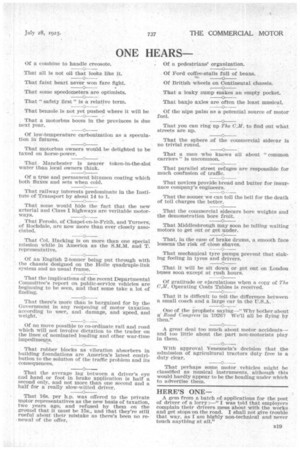ONE HEARS
Page 3

If you've noticed an error in this article please click here to report it so we can fix it.
Of a combine to handle creosote. That all is not oil that looks like it.
That faint heart never won fare fight.
That some speedometers are optimists.
That " safety first" is a relative term.
That benzole is not yet pushed where it will be That a motorbus boom in the provinces is due next year.
Of low-temperature carbonization as a speculation in futures.
That motorbus owners would be delighted to be taxed on horse-power.
That Manchester is nearer token-in-the-slot water than local owners think.
Of a true and permanent bitumen coating which both fluxes and sets when cold.
That railway interests predominate in the Institute of Transport by about 14 to 1.
That some would hide the fact that the new arterial and Class I highways are veritable motorways.
That Ferodo, of Chapel-en-le-Frith, and Turners, of Rochdale, are now more than ever closely associated.
That Col. Hacking is on more than one special mission while .in America as the S.M.M. and T. representative.
Of an English 2-tormer being put through with the chassis designed on the Holle quadruple-link system and no usual frame.
That the implications of the recent Departmental Committee's report on public-service vehicles are beginning to be seen, and that some take a lot of finding.
That there's more than is bargained for by the Government in any reopening of motor taxation according to user, and damage, and speed, and weight.
Of no move possible to co-ordinate rail and road which will not involve dictation to the trader on the lines of nominated loading and other war-time impediments.
That rubber blocks as vibration absorbers in building foundations are America's latest contribution to the solution of the traffic problem and its consequences.
That the average lag between a driver's eye and hand or foot in brake application is half a second only, and not more than one second and a half 'for a really slow-witted driver.
That 16s. per h.p. was offered to the private motor representatives as the new basis of taxation, two years ago, and refused by them on the • ground that it must be 15s., and that they're still rueful about their mistake as there's been no renewal of the offer. Of a pedestrians' organization.
Of Ford coffee-stalls full of beans.
Of British wheels on Continental chassis. That a leaky sump makes an empty pocket. That banjo axles are often the least musical.
Of the nipa palm as a potential source of motor fuel.
That you can ring up The (UT. to find out what streets are up.
That the sphere of the commercial sidecar is no trivial round.
That a man who knows all about "common carriers" is uncommon.
That parallel street refuges are responsible for much confusion of traffic.
That novices provide bread and butter for insurance company's engineers.
That the sooner we can toll the bell for the death of toll charges the better.
That the commercial sidecars bore weights and the demonstration bore fruit.
That Middlesbrough may soon be telling waiting motors to get out or get under.
That, in the case of brake drums, a smooth face lessens the risk of close shaves.
That mechanical tyre pumps prevent that sink ing feeling in tyres and drivers. 0 That it will be sit down or get out on London buses soon except at rush hours.
Of gratitude or ejaculations when a copy of The C.M. Operating Costs Tables is received.
That it is difficult to tell the difference between a small coach and a large car in the U.S.A.
One of the prophets saying—" Why bother about a' Road Congress in 1926? We'll all be flying by then."
A great deal too much about motor accidents— and too little about the part non-motorists play in them.
With approval Venezuela's decision that the admission of agricultural tractors duty free is a duty clear.
That perhaps some, motor vehicles might be classified as musical instruments, although this would hardly appear to be the heading under which to, advertise them.




























